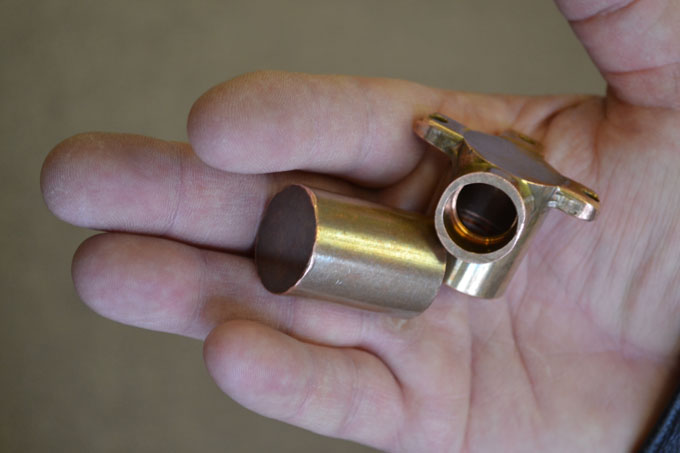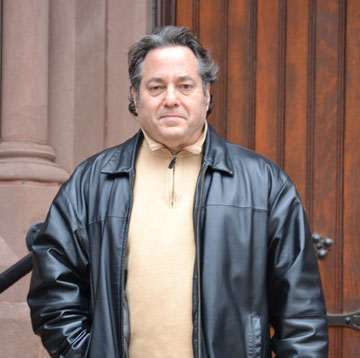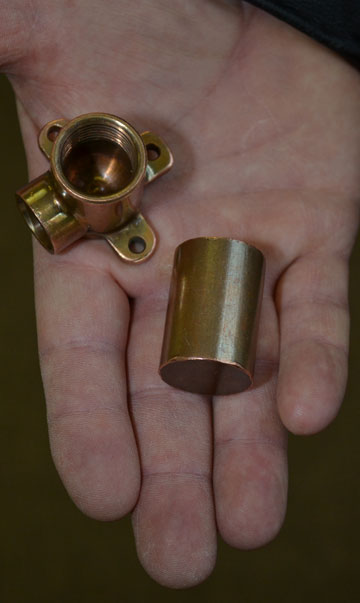Meet Glenn Thomas of Adiabatic Solutions: First Place in the 43North Business Competition
by Ethan Powers


And the Winner is...
Randall Lane, a prominent business reporter, entrepreneur and editor of Forbes Magazine was one of six accomplished judges sitting in Sheas’s Performing Arts Center on October 30th. He was intently listening to the final pitches of the 43North business competition’s 11 remaining startups poised to win $1 million for their respective companies. Upon hearing Adiabatic Solutions (ASi) CEO Glenn Thomas confidently discuss his company’s potential to return American manufacturing jobs by transforming a century-old process, Lane told him what a packed Shea’s was already thinking—that if the process is as good as Thomas claims, this could be the next big thing in manufacturing.
That “next big thing” is located right here in western New York, and now, as the winners of the 43North competition, they have $1 million of extra financing to bring the already lofty ambitions of Adiabatic Solutions, LLC to new heights.
A “startup” eight years in the making, ASi is methodically breaking the stigma attached to companies in the financing stage that the best chance at success for startups is to scramble for early rounds of funding and rush a product to market in the hope that initial value and public reaction will be enough to sustain its long-term prospects. CEO Glenn Thomas and his firm have spent $1.5 million and almost a decade testing and improving a metal forming technology they believe could utterly transform the modern manufacturing process.
Thomas was first introduced to the technology back in 2002 as a chief engineer at GreatBatch Inc.’s implantable power source division. The novel method involves using a high velocity impact to set a metal into a softened, gel-like state for a fraction of a second, allowing it to be pressed into a mold. Thomas worked side-by-side with NIBCO Inc. as a team of engineers worked to develop the machine. When the company began to focus on industrial plastics, Thomas formed and incorporated ASi in 2008 and would later purchase the machine and its intellectual property rights in 2011.
Today, from the company’s Tonawanda manufacturing space, ASi’s six employees are not manufacturing metal parts by conventional means. Traditional metal manufacturing, often called “subtractive manufacturing,” begins with a chunk of metal and is cut to a desired shape and size by taking away mass. But ASi is not cutting metal or using cold-working bending. Instead, they are manufacturing metal parts using an entirely new phenomenon called “adiabatic softening” that can rapidly make parts that are both stronger and lighter.

“When you hit a metal fast enough, you basically send a shockwave through the metal that instantly heats it. The metal is softened for like two tenths of a millisecond before the heat dissipates,” said Thomas. “When it softens you can push it, and that’s what we do. It’s a totally different phenomenon for making parts.”
Thomas and ASi are so confident in the process, they believe it’s only a matter of time before their grand ambitions to reverse the trend of American corporations offshoring manufacturing jobs becomes a reality.
“The name of the game is always productivity,” said Thomas. “The classical definition is the amount of revenue you can get per employee. If you’re a manufacturing company, you have to maximize that. With our technology, the revenue per person is through the roof because the process is so fast, provides great quality products and we’re reducing costs significantly.”
Yet even with effective new technology available domestically, questions will indelibly arise over the viability of American manufacturing and its ability to keep pace with international competition with less regulation, oversight, and significantly fewer labor standards. Apple Inc. for example, even amidst the controversy over its horrid working conditions for employees of the Chinese factories where company products are assembled, has held steady profit margins by working said employees more and paying them less than would be required by U.S. law. Thomas however, is committed to reestablishing the “Made in the USA” ideal, saying that ASi has the potential to establish contracts even with the likes of Apple, and beat out international competition while doing it.
“That’s something I can’t talk about just yet, but we’re working with a huge company on proving the performance of simple parts like the metal contacts in your iPhone, basically making them smaller and still carrying the same amount of current, which will save them a ton of money,” he said.
The concept of undercutting manufacturing companies abroad is no longer hypothetical, as ASi recently received its first purchase order by beating a Chinese manufacturer’s price by 25 percent. Thomas states that the company that ASi received the order from, which he does not yet want to reveal, makes over 3 million shaped charge units a year that are used for hydraulic fracking. Shaped charges are used within the fracking industry to pierce the geologic formation around drilled wells in order to harvest the hydrocarbons lying beneath, which are then transferred to the well surface.
Thomas contends that ASi is much more eco-friendly than the company’s subtractive manufacturing counterparts, which utilize hazardous coolants and must dispose of scrap metal. The high-impact machine also uses only about 10 percent of the energy used in the traditional metal forming process.
However, the politics and potential environmental ramifications around fracking remain a contentious national debate over concerns that fracking can cause damage to local air and water supplies, and can even cause seismic events by reducing the natural stress along fault lines. Danger also lies within the shaped charges themselves; if one of the charges overblows a hole, gas or oil could seep back into the main well, going back to the surface.
Last December, the Erie County Legislature voted 9-2 on a law banning hydraulic fracturing on county-owned property. It also prohibits introducing drilling waste into any county-owned facility such as a wastewater treatment plant and outlaws spreading of “fracking” byproducts on county roads.
While hydrofracking has yet to occur in New York State, and while the law does not affect property owned by private industry, the Legislature’s decision is not without irony in relation to ASi, given the company’s potential economic contributions to the area. The only danger, according to Thomas, occurs in a well blowout scenario in which well casings fail, releasing contaminants into the water supply.
“When they’re drilling down they put casings in place to protect against spills. Only when the casings fail can the oil get into the wells. That’s very rare and they’re improving the casings all the time,” he said.
Thomas is adamant that ASi’s contributions will be much further reaching. The company has already made contact with one of the “Big Three” automotive companies in regard to using ASi’s unique process to manufacture key automobile components faster and more effectively.
“We were told by one of their chief power train engineers that the fact that we can make the metals significantly stronger means they can make their parts lighter, like on the valve train,” said Thomas. “Making the valve train lighter is going to save them fuel. They’ll have a more robust design that’s lighter and saves fuel.”
As ASi begins to perfect their distinctive manufacturing technique, the potential to reach a variety of markets and industries is limitless. With the adiabatic technology, ASi can make medical implants stronger and last longer, which will lower the costs for the consumer, who in turn will need fewer operations or replacements. Aeronautical companies could utilize the process to potentially improve the performance of jet engines. Thomas also notes that the technology is being used to research lightweight body armor with improved strength and ballistic resistance, as well as better performing projectiles.
With unquestionably sexier options competing with ASi for the 43North $1 million prize, ranging from a virtual fitting room that clothing retailers can use to help consumers determine how a particular item might fit, to an implantable biosensor that uses live cells within a tiny device to help physicians measure how effective chemotherapy drugs are on an individual patient, Thomas points to the fact that ASi had already received a purchase order as a main factor in the judges’ decision.
The contest itself, which attracted almost 7,000 entries from 96 countries and all 50 states, was included as part of Governor Cuomo’s Buffalo Billion initiative. The competition offered a total of $5 million in prize money to startups ($1 million to the top idea, six $500,000 awards and four $250,000 awards) with the condition that the winners agree to operate their business in Buffalo for a minimum of one year.
Jordan Levy, the head of 43North’s steering committee, was in the room while the judges deliberated. He echoed Thomas’ sentiments, saying that at the end of the day, the judging panel decided the winner by the ranking system and did not give an unfair bias to the hometown company.
“They felt like it was a company that was very sustainable,” said Levy. “They felt like there was a strong commercial application, and that the technology wasn’t just science anymore but was actually ready for production.”
Currently, ASi operates with a team of just six employees, though Thomas estimates that number rising to 40 within five years. He can also see the company moving to a next-level manufacturing facility in Buffalo should he find the proper space.
Keith Blakely is the president and CEO of the InVentures Group—a public relations and marketing firm specializing in high tech startups that offer infancy companies capital-raising strategies and business plan development. InVentures has played a significant role in helping ASi with financing and marketing approaches. Another InVentures client, New Zealand-based Nuenz Ltd., is focused on the development and commercialization of advanced silicon nitride nanofibers—an advanced ceramic material that has potential in an array of industrial applications due to its corrosion resistance and high fracture toughness.
“They’re stiffer and stronger than titanium,” said Blakely of these advanced ceramic materials. “As stiff and strong as titanium is, ceramics go beyond that, so if you make a blend of these things, you can make a part that is even stronger for aerospace, automotive, biomedical, and so on.”
Blakely believes that if Nuenz can relocate to Buffalo with assistance under the Start-Up NY program should they be able to qualify (the program offers 10 years of tax free operation to companies with the commitment to the economic development of the community), that the synergy which would be created between ASi and Nuenz could prospectively turn Buffalo into a manufacturing hub with limitless growth and economic viability.
With potentially industry-transforming companies like ASi ready to set up shop in Buffalo, in addition to a host of big-name businesses and corporations committing to the area’s economic resurgence, the future of the city’s business prospects is bright indeed. Thousands of companies from nearly 100 countries were willing to apply to the 43North competition, even amidst, and in some cases perhaps because of, the conditional requirement of relocating to the city for at least one year. Levy believes that the foundation has been laid for Buffalo to become a hub and mecca for startups.
“It was not specifically to have a business plan competition, but designed as an economic development tool that helps the revitalization of western New York,” he said. “What this did was serve as a vehicle to say to the world that this is a place where startups can get money and be successful.”
blog comments powered by Disqus
|
Issue Navigation> Issue Index > v13n48 (Gift Guide, Week of Thursday, November 27) > Meet Glenn Thomas of Adiabatic Solutions: First Place in the 43North Business Competition This Week's Issue • Artvoice Daily • Artvoice TV • Events Calendar • Classifieds |









 Current Issue
Current Issue